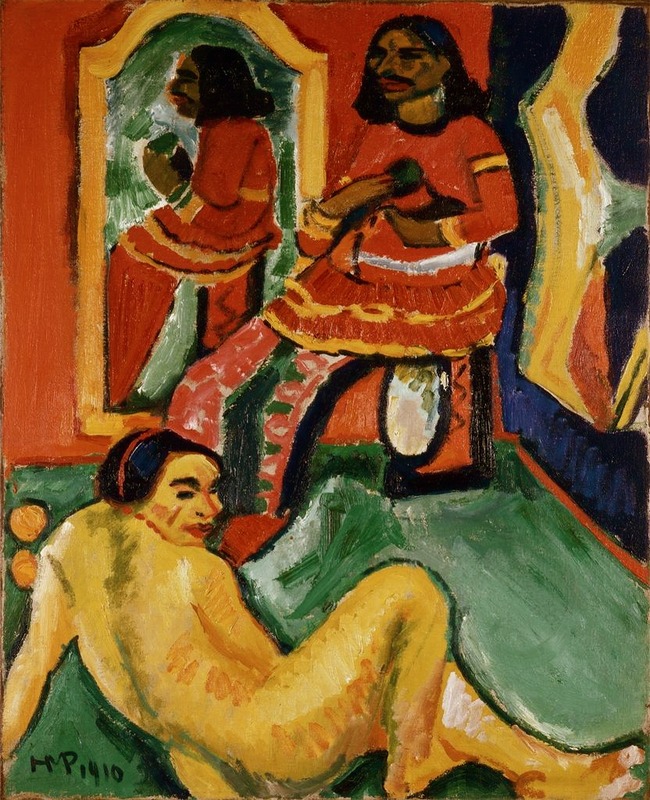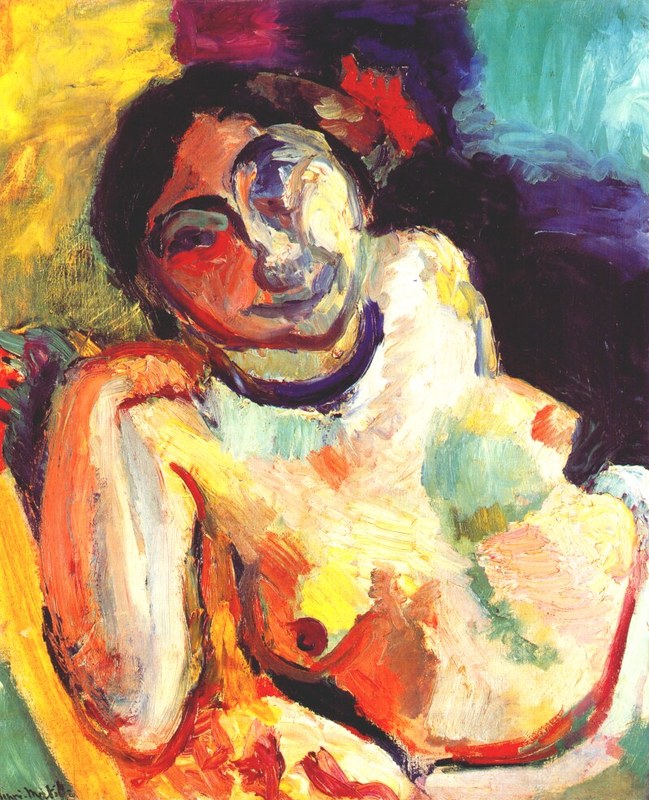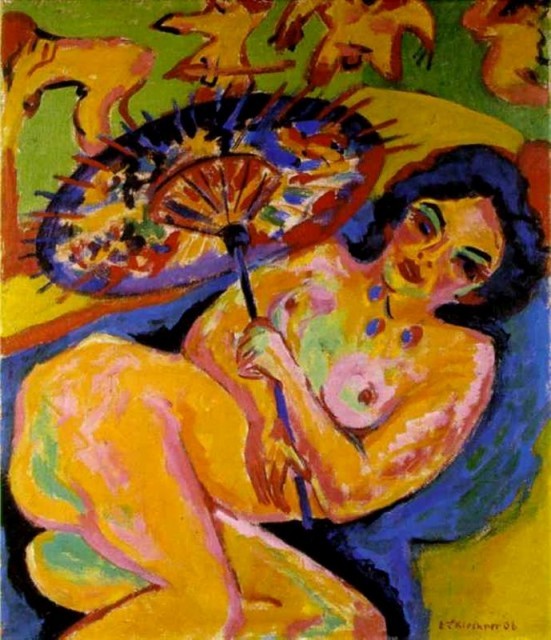In Max Pechstein’s small oil painting Indian and Woman, 1910, the primitivist nude acts as the focal point. Like the other members of the Bridge, Pechstein idealized non-Western cultures, and he sought to capture their enigmas through color and form. Yet, Pechstein is often seen as a peripheral member of the Bridge, especially since he spent less time in Dresden than the other artists and more time in France. In her essay “Max Pechstein: Outsider or Trailblazer?” Aya Soiku claims that fellow Bridge artist Kirchner criticized Pechstein and “portrayed him as a well-behaved academy pupil who allegedly had great trouble adapting to the Brücke’s ideas.”[1] While Pechstein did not fully conform to the Bridge’s radical new ideas, he did use their heavy, thick brushstrokes and solid, unmixed colors on the form. He also drew from post-impressionism and Fauvism, especially Matisse’s works. In his Indian and Woman, Pechstein portrays two figures, one an Indian man and the other a woman whose face resembles an Oceanic mask. Pechstein represents them using the emblematic bright, jarring colors of the Bridge group, yet presents the nude in a contrived studio scene that is lavishly decorated.
In this painting, Pechstein uses the nude to evoke a sense of provocation and discomfort in the audience. The woman looks out at the viewer as though he or she is intruding on her space. There is an odd contrast between her and the clothed man sitting near the mirror. He sits above her on a pedestal as she lays beneath him on the ground, facing him in an evocative pose. Here, the nude does not seem like a celebration of the human body, but rather, it is exploited. The body is being objectified, used for the viewing pleasure of the Indian man referred to in the title It is a possession, not a human life. However, Pechstein portrays a man from a culture different from his own as well, also showing him as “exotic.” This clash of cultures illustrates the Bridge artists’ fascination with, but also their misunderstandings of people from different countries. Pechstein puts an Indian man and woman with a face that resembles an Oceanic mask in the same room, blending their cultures rather than identifying them as individual.
Matisse’s The Gypsy is another portrayal of the nude that calls attention to the ostensible outsider in her most vulnerable form. Pechstein drew from Matisse and Fauvism, engaging it in his own work. Both Matisse and Pechstein focus on the sexuality of these women, which they contrived to be open and promiscuous. In The Gypsy, the woman invites the viewer to look at her breasts, extending her arm in a way that reveals them. She engages the audience with her face, like Pechstein’s woman, but also her body language. However, while the Gypsy woman smiles, letting the viewer look at her figure, Pechstein’s nude woman seems to glare at the viewer, accusingly. She shows her body only to the Indian man who sits above her. Yet, both nudes are painted in bright, non-naturalistic, unmixed colors with apparent brush strokes, emblematic of Fauvism and German Expressionism. The brush strokes sweep the viewer’s eye around the curves of the Gypsy woman’s figure, and the woman also seems to be wearing a bright red flower in her hair, indicative of her ostensible connection to nature and her bold sexuality.
These two nudes portray the misconceptions that artists of this period had in terms of primitivism- they believed that women living outside of conventional Western standards were sexually promiscuous, and they depicted them this way through the poses of the female nude. In addition, there was the idea of primitivism that the non-Western woman was closer to nature than Europeans were. Pechstein shows this in the nude woman, whose face has a masklike quality similar to the artwork of the Oceanic tribes that Pechstein studied at the Dresden Ethnographical Museum and later in Palau. Matisse shows this through use of the flower and the inviting breasts. By melding the sexually open nude with references to non-Western masks, Pechstein reinforces the stereotype about the connection between non-Western peoples and sexuality. Matisse does the same with gypsy culture and unsubtle promiscuity. Both artists portray the woman as sexually confrontational, whether to the viewer or another person in the scene.
Pechstein also uses the nude primarily to contrast how ornately dressed the man is in the painting, which establishes a negative power dynamic between the two figures. Although both figures are from cultures different from Pechstein’s, the artist still portrays the man as superior to the woman. The contrived studio scene the figures are in is an elaborately adorned space, which shows Pechstein’s “decorative” style.[2] He focuses on the accentuating the background ornamentation and man’s clothing. However, the lush environment causes the nude woman to seem out of place in the space, as she is the only aspect of the painting not decoratively adorned. The man wears lavishly ornamental clothing, which is accentuated through its duplication in the mirror on the far wall. All the walls and the floor are painted in bright, primary colors. The decoration of the setting and garb of the Indian man make the woman’s nudity even more ostensible to the viewer.
The artificial setting of Indian and Woman is reminiscent of other early twentieth century primitivist works derived from studio scenes, such as Pablo Picasso’s Les Demoiselles d'Avignon, 1907. Both paintings are manufactured studio works that show the conflation of non-Western cultures and promiscuity. Picasso’s Les Demoiselles d'Avignon shows five prostitutes, two of which have faces that resemble tribal masks like the woman in Indian and Woman. While the nude in Indian and Woman has the curvature of a classical nude, Pablo Picasso employs angular, geometrically sharp nude figures in Les Demoiselles d'Avignon. Despite the difference in the rendering of form, Picasso’s figures are positioned in similarly provocative poses to Pechstein’s nude woman. They engage the viewer directly, inviting them in like the woman in The Gypsy. They hold their arms up, exposing themselves in artificial, confrontational poses. Their background is abstract and maintains a similarly enigmatic feel to Pechstein’s painting. The women are portrayed as wild, yet close to one another, their limbs melding into each other’s. Pechstein and Picasso both connect non-Western cultures with overt and threatening sexuality.
In his painting Girl Under a Japanese Umbrella, 1909, Bridge artistKirchner also depicts the primitivist nude in his Dresden studio. The woman lays provocatively with her breasts exposed and the curves of her body exaggerated beneath a Japanese umbrella. She looks out at the viewers, inviting them to watch her. The distorted form of the body and the seemingly masked face of the figure are similar to Pechstein’s piece, as are the predominantly primary colors that resemble Matisse’s palette as well. Kirchner paints the nude in unmixed paint, with yellow as the predominate hue. Behind the figure, there seems to be a tapestry showing the woman as essentially from a different time and place. This tapestry shows sexual imagery as well, reinforcing the idea of the figure’s unrestricted sexuality. Kirchner contrasts the nude with the elaborative setting to accentuate her body, similar to Pechstein.
In his work Indian and Woman, Pechstein shows a similar practice to other artists such as Matisse, Picasso, and Kirchner in using the studio to manufacture scenes for his painting. Pechstein employs an Indian man and a woman whose features resemble an Oceanic mask, showing his lack of differentiation among foreign cultures. However, while the other artists portray the non-Western nude as sexually inviting to the viewer, Pechstein shows the woman looking over her shoulder, accusing the viewer of intruding on her privacy. Their relationship is enigmatic, and they seem to be in the room together solely because they are not European, but rather, because they represent foreign cultures to Pechstein. Pechstein’s nude is emblematic of the Bridge’s fascination with other cultures, especially the women, considering them secretive, unusual, and perplexing. By recreating these figures in a studio scene, Pechstein shows the restrictions of the Bridge artists and how they could never assimilate into the cultures by which they were inspired. Rather, they were forced to imagine and recreate them in their workshops.
[1] Aya Soika. “Max Pechstein: Outsider or Trailblazer”? New Perspectives on Brücke Expressionism, ed. Christian Weikop, (Ashgate Publishing Company, 2011), 163.
[2] Aya Soika, “Max Pechstein: Outsider or Trailblazer?” New Perspectives on Brücke Expressionism, ed. Christian Weikop, (Ashgate Publishing Company, 2011), 164.



